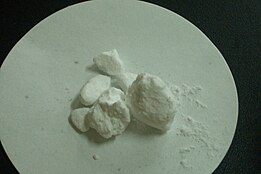 | |
 Unit cell of tripotassium phosphate. | |
| Names | |
|---|---|
| IUPAC name Potassium phosphate | |
| Systematic IUPAC name Potassium tetraoxidophosphate(3−) | |
| Other names Potassium phosphate, tribasic | |
| Identifiers | |
3D model (JSmol) | |
| ChEBI | |
| ChemSpider | |
| ECHA InfoCard | 100.029.006 |
| EC Number |
|
| E number | E340(iii) (antioxidants, ...) |
PubChem CID | |
| UNII | |
CompTox Dashboard (EPA) | |
| |
| |
| Properties | |
| K3PO4 | |
| Molar mass | 212.27 g/mol |
| Appearance | White deliquescent powder |
| Density | 2.564 g/cm3 (17 °C) |
| Melting point | 1,380 °C (2,520 °F; 1,650 K) |
| 90 g/100 mL (20 °C) | |
| Solubility in ethanol | Insoluble |
| Basicity (pKb) | 1.6 |
| Structure [1] | |
| Primitive orthorhombic | |
| Pnma, No. 62 | |
| Hazards [2] | |
| Occupational safety and health (OHS/OSH): | |
Main hazards | Irritant |
| GHS labelling: | |
 | |
| Warning | |
| H319 | |
| P264, P280, P305+P351+P338, P337+P313 | |
| NFPA 704 (fire diamond) | |
| Flash point | Non-flammable |
| Safety data sheet (SDS) | MSDS |
| Related compounds | |
Other cations | Trisodium phosphate Triammonium phosphate Tricalcium phosphate |
Related compounds | Monopotassium phosphate Dipotassium phosphate |
Except where otherwise noted, data are given for materials in their standard state (at 25 °C [77 °F], 100 kPa). | |
Tripotassium phosphate, also called tribasic potassium phosphate [3] is a water-soluble salt with the chemical formula K3PO4.(H2O)x (x = 0, 3, 7, 9). [4] Tripotassium phosphate is basic: a 1% aqueous solution has a pH of 11.8. [4]

